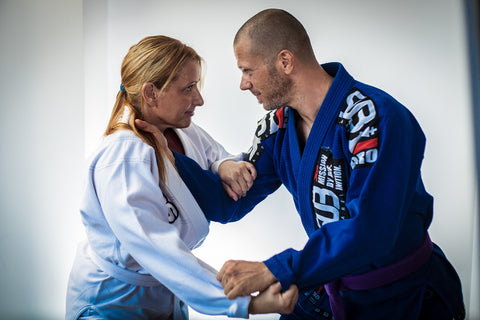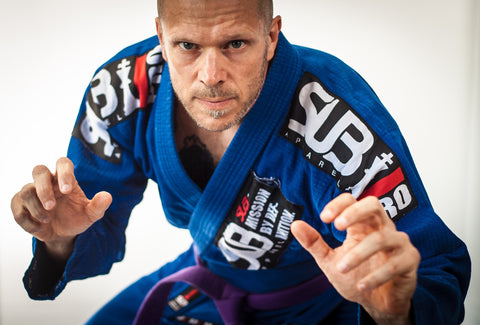There are a few things in life that are just so satisfying to achieve- like finally learning how to ride a bike or mastering your first karate chop. For many people, earning their BJJ belts is one of those accomplishments. Brazilian Jiu Jitsu has a unique ranking system that can be confusing for beginners. In this blog post, we will break down the belts and explain the order in which they should be earned.
White Belt
The first belt in BJJ is the white belt. This is the rank that all beginners start at regardless of their previous martial arts experience. A white belt signifies that a student is new to the sport and still has much to learn. From there, students will progress through the ranks of blue, purple, brown, and black. The order of these belts is not set in stone, and some students may move more quickly through the ranks than others.
When you a white belt you are the smallest fish in the ocean and get to experience what it's like being at the bottom of the totem pole. You will probably be submitted a lot, but that’s okay! It’s all part of the learning process. Just remember to never give up and eventually you will progress through the ranks.
Blue Belt
The blue belt is the first intermediate rank in BJJ. It signifies that a student has learned the basic techniques of Brazilian Jiu-Jitsu and can now begin to put them into practice. Blue belt is often one of the longest belts in BJJ, as it can take many years to achieve a purple belt.
Blue belts are rounded however still make common mistakes. You have probably developed some bad habits from when you were a white belt and now is the time to start fixing them!
A big part of being a blue belt is learning how to self-correct and identify your own mistakes. Remember, there are no stupid questions; so never be scared to ask your coach for assistance.
How long does it take to get your blue belt?
There is no clear answer to this issue since it is determined on a case-by-case basis. Some pupils may progress faster than others, and some may require more time to achieve a blue belt. It takes around 2-3 years to earn a blue belt in BJJ on average.
Purple Belt
The purple belt is the second intermediate rank in BJJ. It signifies that a student has a good understanding of the basic techniques and is now beginning to learn more advanced techniques.
A purple belt should be able to execute all the basic techniques with ease and start adding their own flair to them. You will also be expected to know a wide range of techniques and be able to transition between them smoothly.
Purple belts often can tap out most people but still have trouble with the better players. You should now be starting to think about competition and what your game plan would be if you were to compete.
As a purple belt, you should also be able to teach some of the basic techniques to lower belts. This is an important part of BJJ as it helps to foster a sense of community and allows lower belts to learn from those who have more experience.
How long does it take to get your purple belt?
It usually takes around three to five years to achieve a purple belt. But again, this depends on the individual and how quickly they are able to learn and progress.
Brown Belt
The brown belt is the second-to-last rank in BJJ. It signifies that a student is nearing the end of their journey and is close to becoming a black belt.
A brown belt should be able to execute all the basic and advanced techniques with ease. They will also have developed their own unique style of Jiu-Jitsu and be able to use it effectively in competition.
As a brown belt, you should also be able to teach all the basic and advanced techniques to lower belts. This is an important part of BJJ as it helps to foster a sense of community and allows lower belts to learn from those who have more experience.
How long does it take to get your brown belt?
It takes on average four to six years to achieve a brown belt in BJJ, although this depends on the person and how quickly they learn and improve.
Black BeltThe black belt is the highest rank in BJJ. It signifies that a student has mastered the art of Brazilian Jiu-Jitsu and is now a full-fledged black belt.
A black belt should be able to execute all the basic, advanced, and esoteric techniques with ease. They will also have a deep understanding of BJJ theory and be able to use it effectively in competition.
As a black belt, you are expected to be a leader in the BJJ community and help promote and grow the art. You should also be able to teach all the basic, advanced, and esoteric techniques to lower belts.
Being a black belt in BJJ is a huge accomplishment and it takes many years of hard work and dedication to achieve.
How long does it take to get your black belt?Normally, it takes around ten years to achieve a black belt in BJJ. However, this is subject to the individual's learning and development abilities.

There are Levels to Being a Black Belt
There are many levels to being a black belt in BJJ. It is not simply about mastering the techniques. There is also a lot of theory and philosophy that goes into becoming a black belt.
There are different degrees of being a black belt in BJJ and not everyone who has a black belt is equal. There are people who have a black belt in BJJ but may not be able to use it effectively in competition. And then there are those who have a black belt and are also proficient in teaching the art.
Red / Black belt (Coral belt)
The red and black belt is for those who acquire their 7th-degree black belt. This rank is only held by a few people in the entire world.
Red / White belt (Coral belt)
The red and white belt is for those who acquire their 8th-degree black belt. Before advancing to the next rank, a coach must have at least 10 years of teaching and training experience at the red and white belt levels.
Red belt
The red belt is supposedly given to those who have achieved excellence at the apex of their field, according to Renzo and Royler Gracie. The Gracie brothers were the first to receive red belts from their father, Helio Gracie. A handful of others have been given the privilege since then.
What Are stripes?
In addition to the different belt colors, there are also stripes that indicate a student's progress. There are typically one or two stripes on a belt and they signify that a student is progressing well and making good progress.
A stripe can be added to a belt after a student has passed an evaluation by their instructor. This usually happens every six to twelve months.
Once students acquire four stripes there they are ready for their next belt rank. At Fight Co we support the journey of BJJ for everyone with some of the best GIs and rash guards the market.
Children's Belt Systems
Just like there is a belt system for adults, there is also a belt system for children. The belts are typically white, grey, yellow, orange, and green. Check out the best selling kids rank belt here
The children's belt system was created to help motivate and encourage kids to keep learning and progressing in BJJ. It also instills a sense of accomplishment as they move up the ranks. The children's belt system is not as complicated as the adult system and usually only takes a few months to progress through. The belts also help separate kids' levels in comps.
FAQs
Can a black belt be taken away?
Yes, a black belt can be taken away if the student is no longer active in training or teaching.
What does it mean to 'grade' someone?
Grading someone means to promote them to the next rank.
Can you be a black belt in multiple disciplines?
Yes, it is possible to be a black belt in multiple disciplines.
Do I have to grade every six months?
No, there is no set requirement for grading. It depends on the student's progress and how they are performing.
Conclusion
So there you have it, the BJJ ranking system explained. Whether you’re a beginner or a seasoned black belt, understanding where you fit in and what is expected of you at each belt level can help keep your training on track and give you a goal to strive for. At Fight Co, we have everything you need to take your jiu-jitsu game to the next level!


